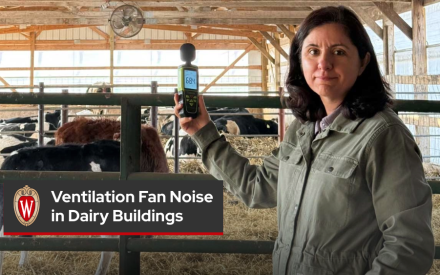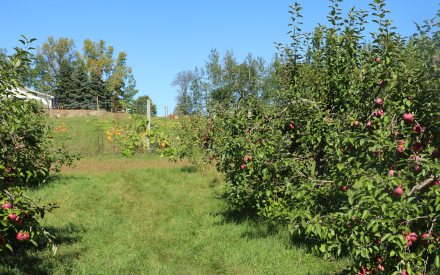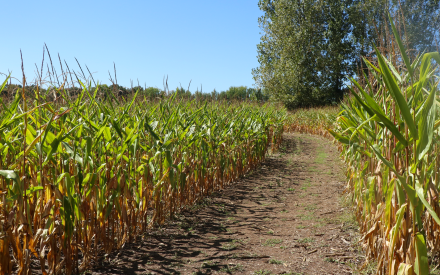Each summer, dairy farm producers and their employees work through days of extreme heat and humidity – often starting in May or June and continuing into September. While we certainly need to protect our dairy cattle during these hot days, it is also an important time to be conscious of how to protect ourselves and our dairy farm workers during summer heat.
Heat-related illness can develop quickly and progress to deadly stages. Heat exhaustion – an early stage of heat-related illness – can turn into heatstroke. A significant percentage of people who develop heatstroke will die. Several studies suggest that high body temperature from working in the heat can impair a person’s ability to think correctly and make complex decisions. Heat can also slow down a person’s reaction time.
It is difficult to give a specific temperature or humidity level that will “warn” farm workers of unsafe conditions. During physical activities, the body generates heat. During intense activities, farm workers can have a hard time cooling themselves. Exposure to direct sunlight also raises body temperature. A person’s ability to stay cool also depends on clothing, conditioning to heat and humidity, and level of health and fitness; air movement will also impact the ability to cool oneself.
What are the signs of heat stress?
Here are a few indicators of heat-related illness and recommendations for treatment from the American Red Cross:
Heat exhaustion: Symptoms are cool, moist, pale, or flushed skin with heavy sweating, headache, nausea, or vomiting, dizziness, and exhaustion. A person with heat exhaustion may have a normal or rising body temperature. If heat exhaustion is suspected, the person should be moved to a cool, shaded place. Their clothing should be loosened, and moist cloths applied to the forehead, wrists, and chest to cool down. A person who is alert should drink cool fluid every 15 minutes. If symptoms do not improve after an hour, a qualified health professional should be consulted. A person with underlying health problems should see a doctor right away.
Heatstroke: Symptoms are hot, red skin, changes in consciousness, a rapid and/or weak pulse, and rapid, shallow breathing. A person experiencing heatstroke can have a high body temperature — sometimes as high as 105 degrees Fahrenheit. Skin will often feel dry. Heatstroke must be treated as a life-threatening emergency and 911 should be called for emergency assistance. While waiting for help, the person must be cooled quickly by being immersed in cool (not ice-cold) water or having saturated cloths applied and sprinkled with cool water. Fans can be used to speed cooling. A person with heatstroke should drink cool liquids, but only if they are alert. The person should be monitored as in any urgent first-aid situation, including if they are properly responsive and comfortable.
What are some steps dairy workers can take to reduce heat stress?
- Plan strenuous tasks for cooler times of the day – morning or early evening.
- Help dairy employees gradually acclimate to hot conditions by initially exposing them to short work periods and more frequent breaks.
- Arrange for work in shaded, well-ventilated areas whenever possible.
- Watch for high temperature/high humidity outdoor conditions and adjust assignments to reduce risk.
- Use fans to help evaporate sweat, providing an important cooling effect.
- Wear lightweight, breathable clothing.
- Wear a hat to provide sun protection when working outdoors. Hats should be loose-fitting and well-ventilated.
- Apply sunscreen to protect against sunburn and skin cancer.
- Drink often! Dehydration accelerates heat illness potential. Water is the best (and least expensive) drink for outdoor work. Sports drinks are OK for most people but avoid sugary soda and caffeine. Salt tablets are not recommended unless a doctor advises them.
- Anyone who must restrict fluid intake because of a medical condition should check with a doctor about how to work safely in hot weather.
Heat-related safety is serious business. Heat exposure kills more people each year than floods, tornadoes, lightning, and hurricanes combined. The American Red Cross and the American Meteorological Society report that heat kills more than 1,000 people each year in the U.S.
By being aware and taking specific actions, people can make sure they and those around them beat the heat.
Resources for medical assistance for workers without health insurance
- Free clinics: Call 2-1-1. These clinics offer medical services to people for free.
- Community centers: https://www.findahealthcenter.hrsa.gov/ and https://www.wphca.org/page/FindHealthCenter
- Medical assistance options for Hispanic farmworkers COVID19 (English and Spanish)

 Ventilation Fan Noise in Dairy Buildings
Ventilation Fan Noise in Dairy Buildings Making your events, festivals, and agritourism accessible to the public
Making your events, festivals, and agritourism accessible to the public Responding to accessibility issues and requests for accommodations for your agritourism event
Responding to accessibility issues and requests for accommodations for your agritourism event Universal design examples for agritourism events
Universal design examples for agritourism events


